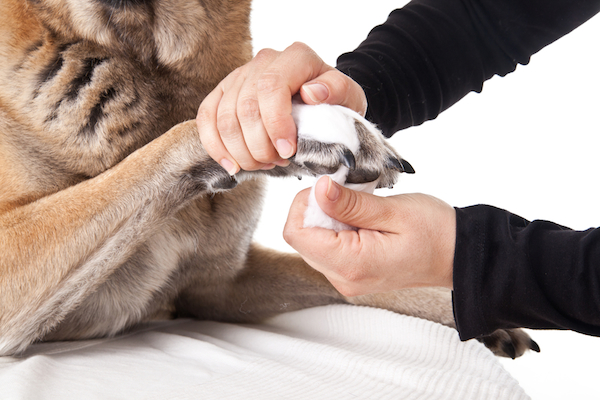Editor’s note: Have you seen the new Dogster print magazine in stores? Or in the waiting room of your vet’s office? This article appeared in our April/May issue. Subscribe to Dogster and get the bimonthly magazine delivered to your home.
As a master-certified pet first aid instructor and the delighted pet parent to a pair of canines named Chipper and Cleo, I’m all about doing my best to keep them out of harm’s way. I keep a well-stocked pet first aid kit in my home, as well as a smaller version in my SUV. When we’re off on a long mountain hike or other outdoor doggie adventure, I pack a smaller pet first aid kit.
But even the most conscious of pet parents among us does not tote a pet first aid kit around 24/7. The reality is that injuries and illnesses in our dogs can occur any place, any time — and usually when our pet first aid kit is not nearby.
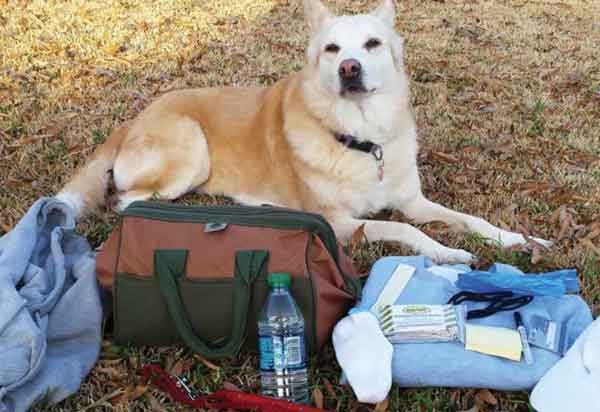
So, what do you do when your dog gets stung by a bee, cuts his paw on a walk in your neighborhood, or suddenly collapses and stops breathing in your living room? Don’t panic. Help is here. In my classes taught all around the country, I not only train people on the pet first aid basics — rescue breathing, performing CPR, stopping arterial bleeds, and more — but also how to unleash their creative “Mutt-gyvers” inside of them. By that, I refer to how to use everyday household items to stabilize and immobilize your dog until he can be safely transported to a veterinary clinic for professional treatment.
Mutt-gyver is my playful canine twist that refers to (and pays homage to) that action-adventure TV show of the late 1980s and early 1990s called MacGyver. The show’s hero, Angus MacGyver, relied on his Swiss army knife, duct tape, shoelaces, and other common items within reach to escape from and foil bad guys each episode.
It’s time we used that same “think outside the box” MacGyver mindset when it comes to rendering emergency pet first aid for our dogs. So, here are some common emergency situations and the everyday items you may be wearing or have within reach to use as makeshift pet first aid tools.
1. Dialing in the many safety features of your cellphone
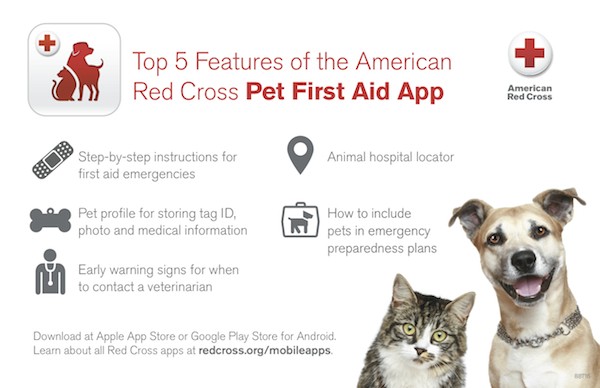
In addition to taking a hands-on pet first aid class, I encourage you to download a pet first aid app, such as the one offered by the American Red Cross, to your cellphone today. Your cellphone is your No. 1 pet first aid tool. The app can provide step-by-step guidance to stabilize your dog. And during a serious emergency, such as if your dog has stopped breathing, you can perform CPR and talk to the nearest veterinarian via the speakerphone setting. Always alert the nearest veterinary clinic that you are en route and give your estimated time of arrival so that it can prepare an exam room. Remember, in a serious pet emergency, every minute counts!
2. Safely restraining your injured dog
Even the mellowest of mutts can bite when in pain, so heed Pet First Aid Rule No. 1: Protect yourself first before rendering care. A six-foot nylon leash can be used as a muzzle restraint to prevent your injured dog from being able to open his mouth wide enough to bite you. This restraint enables him to still breathe.
The key is to form a noose and make the first tie on the bridge of your dog’s nose. Next, tie under the chin, then tie on the back of the neck below the ears, and finish by threading one end under the first tie on the bridge of the nose looped back to the top of the head, where you tie it in a bow (never a knot).
Other Mutt-gyver restraint options: For smaller dogs, you can use the drawstring from a hooded sweatshirt or your sneaker shoelace as a temporary muzzle. Belts may work in some circumstances. For dogs with short muzzles, like Pugs, Boxers, and some Pit Bulls, consider restraining by rolling a thick bath towel around their necks and gripping the ends behind their heads, lifting slightly up to prevent them from being able to open their mouths wide.
3. Administering to cut paws
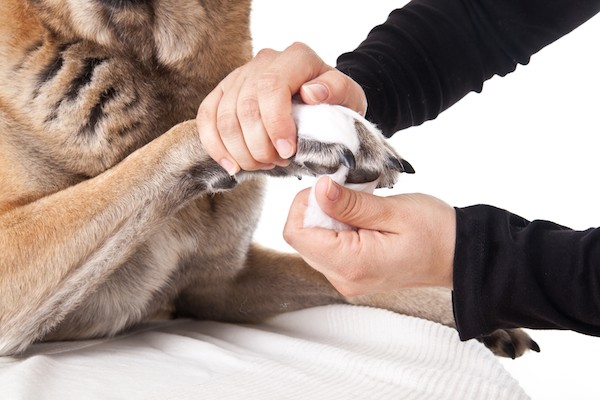
Here’s a lesson I learned a couple years ago when I was on a six-mile hike with friends and their dogs. A 60-pound dog in our group named Katie badly cut her front paw midway through the hike. She was too heavy to lift on the rocky terrain for the three miles back to our base camp. So I cleaned her paw with bottled water, used a bandana to apply pressure to stop the bleeding, and left the folded bandana on the wound. I then wrapped her paw in a white crew sock — you could also wrap the paw in an unused plastic doggie bag — and tied it snugly using a friend’s hair tie. We were able to safely usher Katie back to camp and then on to the veterinary clinic for professional treatment.
Other Mutt-gyver options: If your dog badly strains or breaks his leg on an outing, limit his movement to prevent him from putting any weight on the injured limb. After applying a restraint muzzle, you can make a makeshift splint by using paint stirrers or Popsicle sticks and wrapping the limb in a water bottle, newspapers, or a magazine held in place with shoelaces or a bandana. Dogs too heavy to lift can be placed on your sweatshirt and dragged or carried in a sweatshirt, slinging the ends behind their heads and lifting slightly up to prevent them from being able to open their mouths wide.
4. Treating bee or wasp stings
Bees, in particular, are driven creatures on pollinating missions. During the heat of the day, they often scurry from low-level flowers and ground covers. You can reduce your dog’s chance of being stung by steering him away from ground cover on your leashed walks and making sure he heeds the “come back” cue from you, so he doesn’t inadvertently poke his nose into a beehive.
If you can see the stinger, slide the edge of your credit card or driver’s license against the stinger to usher it out. (See this photo of my dog, Cleo, going belly up to have me practice removing a pretend stinger from her belly via a credit card.)
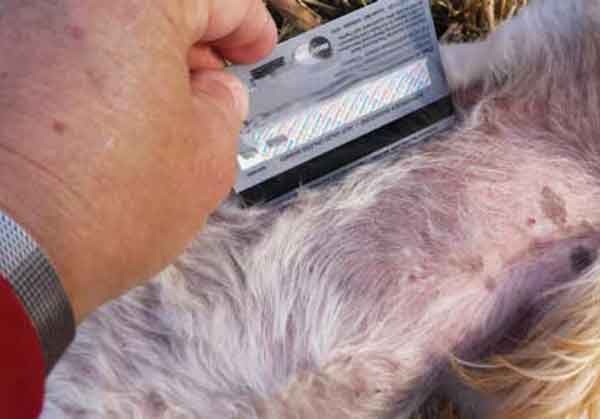
Do not use tweezers or your fingernails to attempt to remove the stinger because you will risk rupturing the poison sac. Keep your dog calm, and take him to the veterinary clinic if the area swells and he develops breathing difficulties. If you do have an antihistamine available to give your dog, make sure that the only ingredient is diphenhydramine.
5. Treating a dog who gets too hot or too cold
Dogs perspire through their paws. On superhot days, keep your dog cool by dipping his paws into cool water. You can pour bottled water into your baseball cap if necessary.
On cold days, coat your dog’s paws in petroleum jelly to prevent ice crystals or salt from cutting the paws. And heed the motto to “hug, not rub” to warm your dog who might be suffering from frostbite. Place a small dog inside your winter coat to gradually warm up from your body heat. Wrap a large dog in a Mylar blanket — that lightweight, shiny blanket that marathon runners and campers use to retain heat.
Have you used a Mutt-gyver trick when performing first aid on your pup? Share in the comments!
Read more on being prepared for emergencies with your dog:
- How to Make a DIY Dog First-Aid Kit for Car Travel
- 15 Must-Have Items for Your Dog First Aid Kit
- 8 Dog First Aid Items You’ve Probably Left Out of Your Kit
About the author: Arden Moore, The Pawsitive Coach, is a pet behavior consultant, master certified pet first aid instructor, author, and host of the Oh Behave! show on Pet Life Radio. Learn more at Four Legged Life and follow her on YouTube, Facebook and Twitter.

